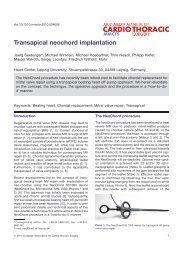The surgical anatomy of the aortic root - Multimedia Manual Cardio ...
The surgical anatomy of the aortic root - Multimedia Manual Cardio ...
The surgical anatomy of the aortic root - Multimedia Manual Cardio ...
You also want an ePaper? Increase the reach of your titles
YUMPU automatically turns print PDFs into web optimized ePapers that Google loves.
R.H. Anderson / <strong>Multimedia</strong> <strong>Manual</strong> <strong>of</strong> <strong>Cardio</strong>thoracic Surgery / doi:10.1510/mmcts.2006.002527<br />
Schematic 1. <strong>The</strong> cartoon shows a bisected <strong>aortic</strong> <strong>root</strong>, and illustrates<br />
how <strong>the</strong> semilunar attachment <strong>of</strong> <strong>the</strong> valvar leaflets incorporates<br />
<strong>aortic</strong> wall in <strong>the</strong> intersinusal triangles, and ventricular tissues<br />
at <strong>the</strong> base <strong>of</strong> each <strong>of</strong> <strong>the</strong> coronary <strong>aortic</strong> sinuses.<br />
attachments at <strong>the</strong> sinutubular junction (Photo 3). <strong>The</strong><br />
<strong>root</strong> as thus defined, <strong>the</strong>refore, is a cylinder, its walls<br />
being made up <strong>of</strong> <strong>the</strong> <strong>aortic</strong> valvar sinuses along with<br />
<strong>the</strong> interdigitating intersinusal fibrous triangles, and<br />
with two small crescents <strong>of</strong> ventricular muscle incorporated<br />
at its proximal end (Schematic 1).<br />
It is <strong>the</strong> semilunar attachments <strong>of</strong> <strong>the</strong> leaflets within<br />
<strong>the</strong> valvar sinuses that form <strong>the</strong> haemodynamic junction<br />
between <strong>the</strong> left ventricle and <strong>the</strong> aorta. All structures<br />
on <strong>the</strong> distal side <strong>of</strong> <strong>the</strong>se attachments are<br />
subject to arterial pressures, whereas all parts proximal<br />
to <strong>the</strong> attachments are subjected to ventricular<br />
pressures. In functional terms, all three sinuses <strong>of</strong> <strong>the</strong><br />
<strong>root</strong>, and <strong>the</strong>ir contained leaflets, are identical. Anatomically,<br />
however, it is necessary to distinguish<br />
between <strong>the</strong> three components. This is best achieved<br />
by noting that two <strong>of</strong> <strong>the</strong> valvar sinuses give rise to<br />
<strong>the</strong> coronary arteries (Photo 4). <strong>The</strong>se can be nominated<br />
as <strong>the</strong> right and left coronary <strong>aortic</strong> sinuses.<br />
<strong>The</strong>se two sinuses, for <strong>the</strong>ir greater part, are made up<br />
<strong>of</strong> <strong>the</strong> <strong>aortic</strong> wall. But, because <strong>the</strong> semilunar attachments<br />
<strong>of</strong> <strong>the</strong> leaflets cross <strong>the</strong> anatomic ventriculo<strong>aortic</strong><br />
junction, a crescent <strong>of</strong> ventricular musculature<br />
is incorporated at <strong>the</strong> base <strong>of</strong> each <strong>of</strong> <strong>the</strong>se two sinuses<br />
(Photo 3, Schematic 1). <strong>The</strong> third sinus does not<br />
give rise to a coronary artery, and hence, can be designated<br />
as <strong>the</strong> non-coronary <strong>aortic</strong> sinus. <strong>The</strong>re is no<br />
muscular crescent at <strong>the</strong> base <strong>of</strong> this sinus, since this<br />
sinus has exclusively fibrous walls, <strong>the</strong> basal part<br />
beneath <strong>the</strong> anatomic ventriculo-<strong>aortic</strong> junction being<br />
part <strong>of</strong> <strong>the</strong> important continuity between <strong>the</strong> leaflets<br />
<strong>of</strong> <strong>the</strong> <strong>aortic</strong> and mitral valves that is a feature <strong>of</strong> <strong>the</strong><br />
outflow tract <strong>of</strong> <strong>the</strong> left ventricle (Photo 5).<br />
<strong>The</strong> areas between <strong>the</strong> basal attachments <strong>of</strong> <strong>the</strong> <strong>aortic</strong><br />
sinuses within <strong>the</strong> ventricle itself, which extend distally<br />
to <strong>the</strong> level <strong>of</strong> <strong>the</strong> sinutubular junction, are<br />
triangular extensions <strong>of</strong> <strong>the</strong> left ventricular outflow<br />
tract. <strong>The</strong>y are thinned fibrous areas <strong>of</strong> <strong>the</strong> <strong>aortic</strong> wall.<br />
Photo 4. <strong>The</strong> heart has been dissected by removing <strong>the</strong> atrial chambers<br />
and <strong>the</strong> arterial trunks, and is photographed from above, looking<br />
down on <strong>the</strong> atrioventricular and ventriculo-arterial junctions. It<br />
is orientated as it may be seen by <strong>the</strong> surgeon. <strong>The</strong> dissection<br />
shows how two <strong>of</strong> <strong>the</strong> <strong>aortic</strong> valvar sinuses (1, 2) give rise to<br />
coronary arteries, and can be nominated as <strong>the</strong> left and right coronary<br />
<strong>aortic</strong> sinuses, respectively. <strong>The</strong> third sinus (3) does not give<br />
rise to a coronary artery, and hence, is <strong>the</strong> non-coronary <strong>aortic</strong><br />
sinus. Note again that <strong>the</strong> <strong>aortic</strong> valve forms <strong>the</strong> cardiac<br />
centrepiece.<br />
Photo 5. <strong>The</strong> <strong>aortic</strong> <strong>root</strong> has been opened from <strong>the</strong> front, and <strong>the</strong><br />
leaflets <strong>of</strong> <strong>the</strong> <strong>aortic</strong> valve removed. <strong>The</strong> dissection shows how <strong>the</strong><br />
interleaflet triangle between <strong>the</strong> non-coronary and left coronary <strong>aortic</strong><br />
sinuses (purple dashed line) is part <strong>of</strong> <strong>the</strong> area <strong>of</strong> fibrous continuity<br />
with <strong>the</strong> <strong>aortic</strong> leaflet <strong>of</strong> <strong>the</strong> mitral valve. <strong>The</strong> red dotted line<br />
marks <strong>the</strong> anatomic ventriculo-<strong>aortic</strong> junction.<br />
3




